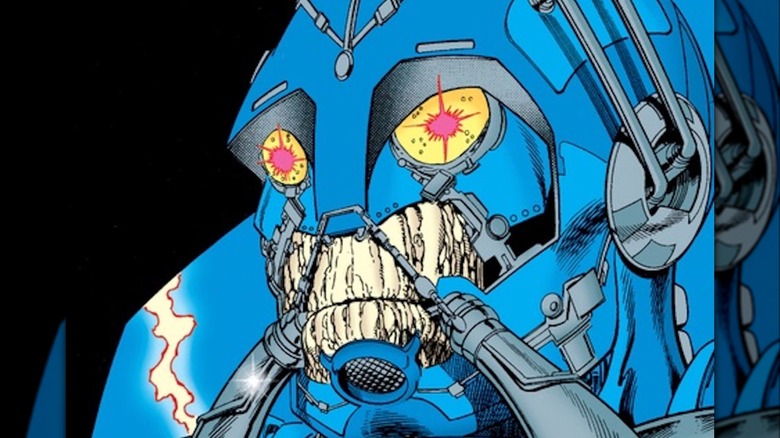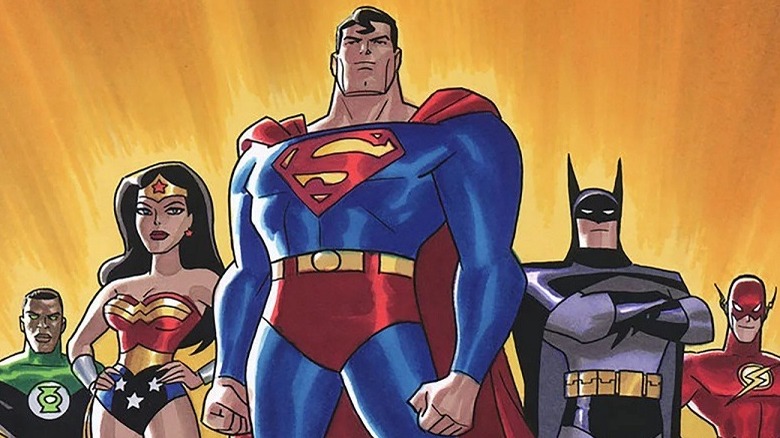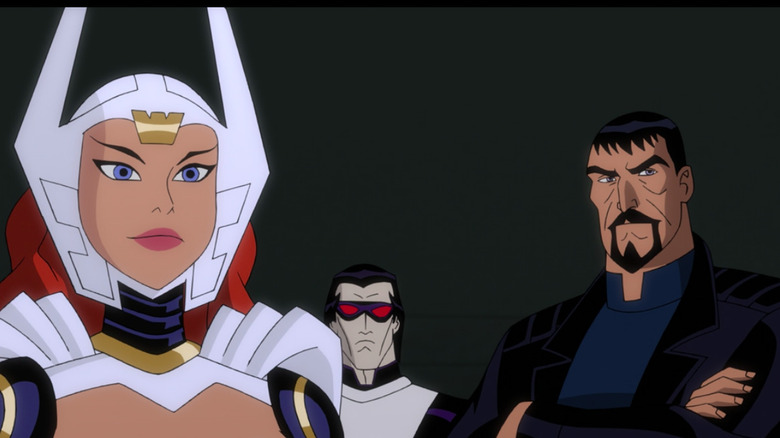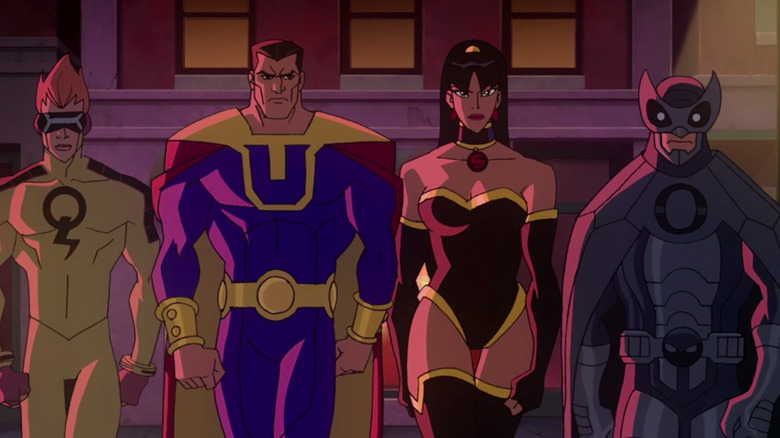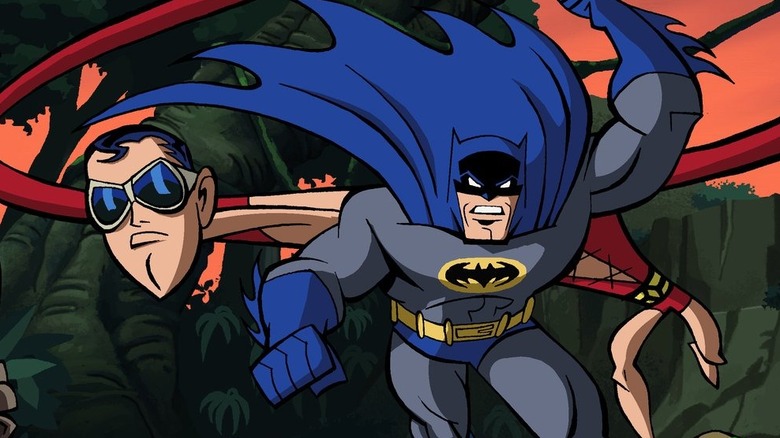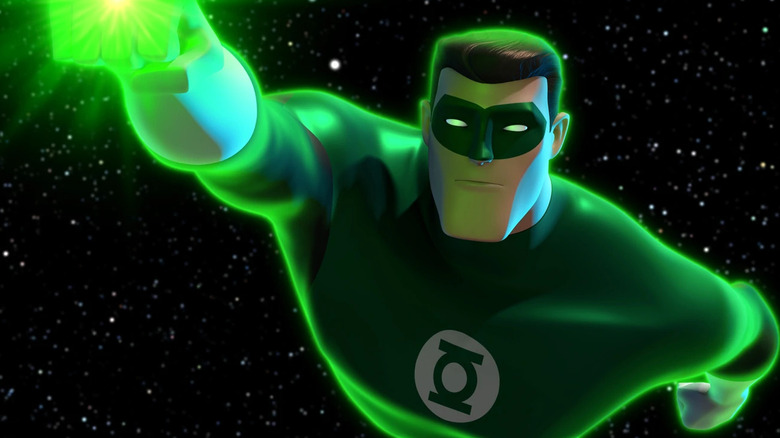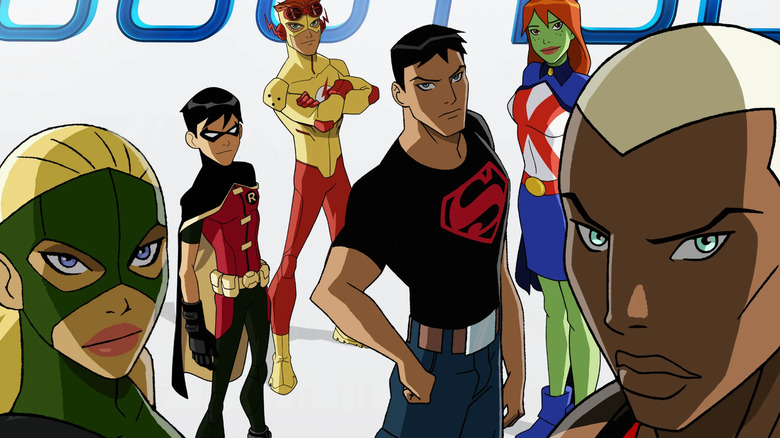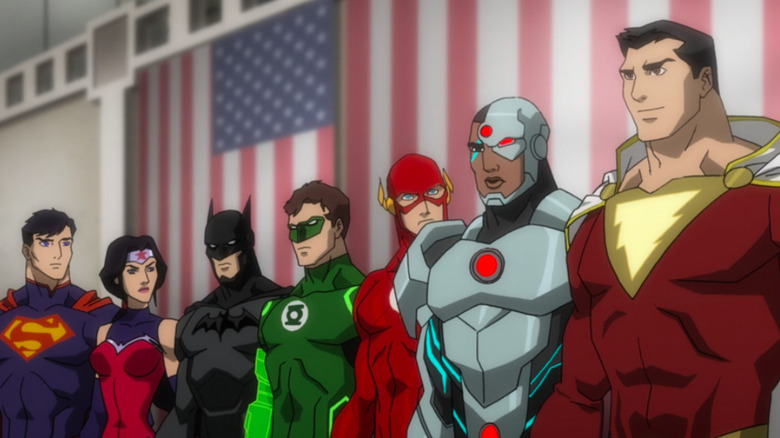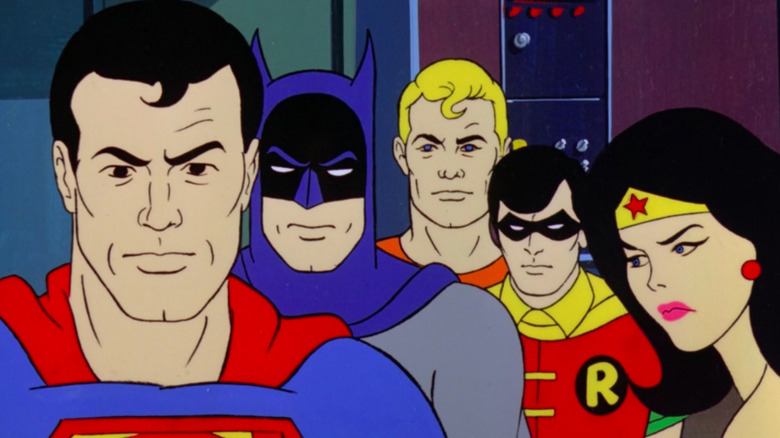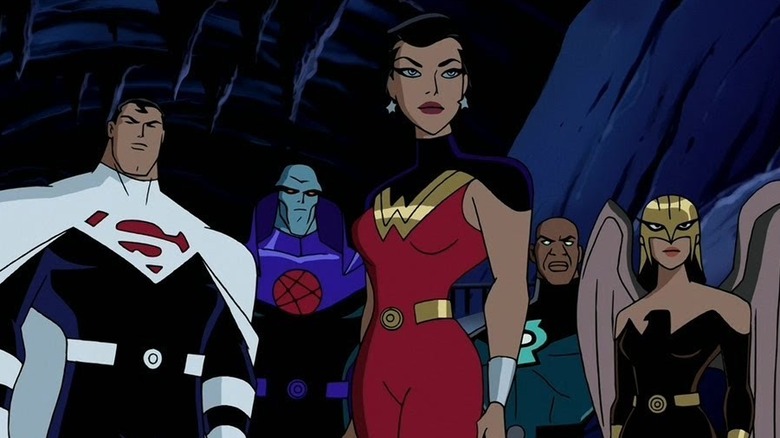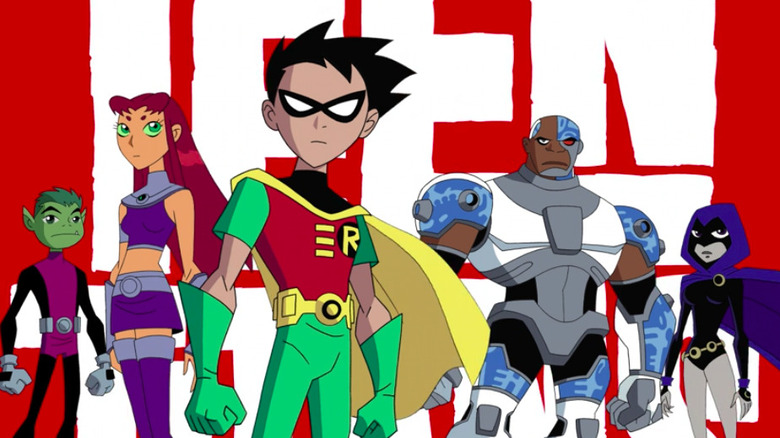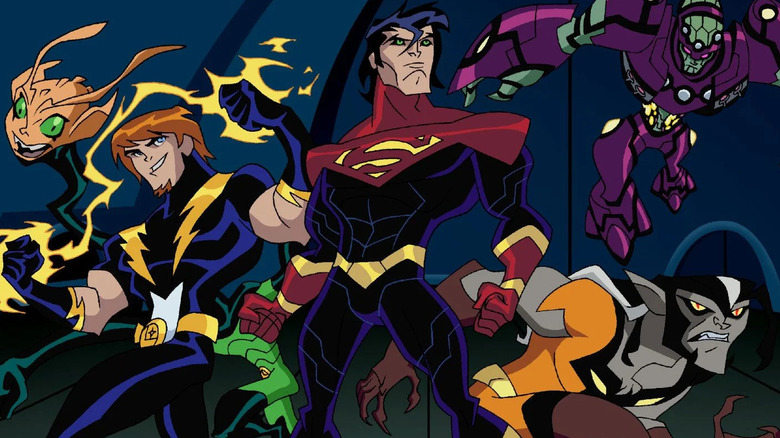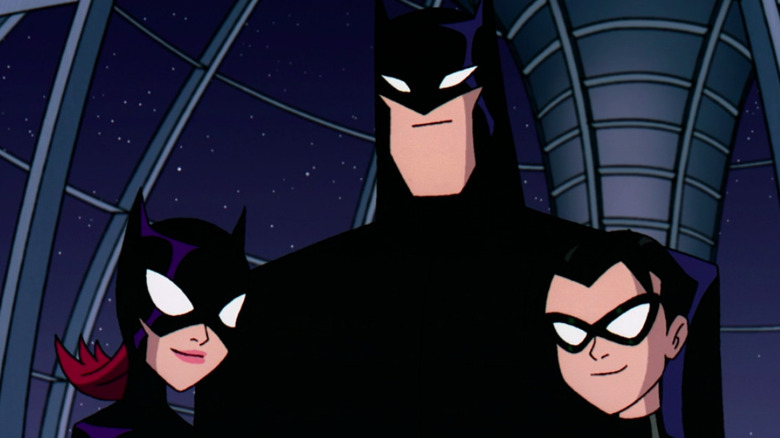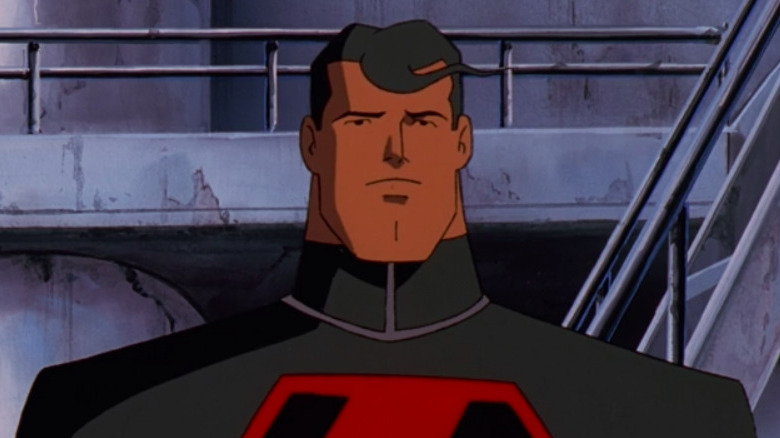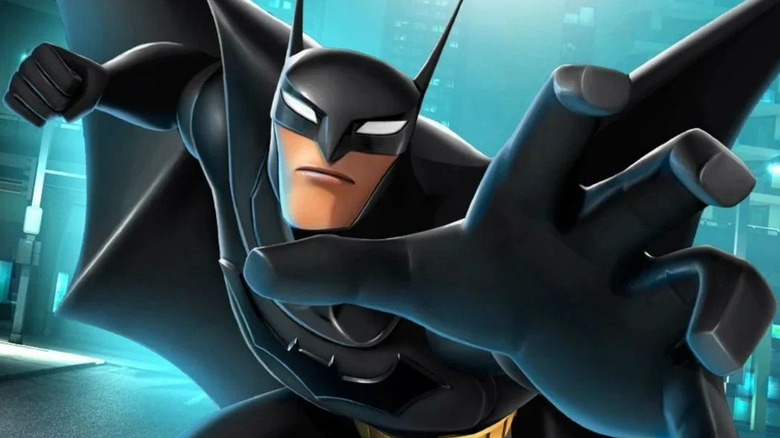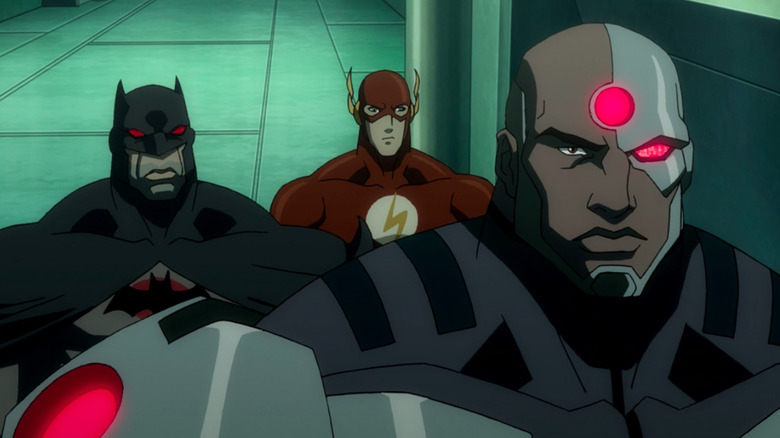Crisis On Infinite Earths: Universes We'd Want To See In An Animated Version
If you're a fan of DC and Marvel, then you know the multiverse is all the rage these days. Therefore, it may come as little surprise to hear there are rumors of a new adaptation of DC Comics' famed "Crisis on Infinite Earths." Unlike the recent Arrowverse adaptation, however, this "Crisis" will be an animated, direct-to-video version split into three movies, according to Cines Argentinos writer Matías Lértora on Twitter (and translated into English by Yojimbo of DCAU Resource). The rumor further claims that rather than feature universes from the original comic, this "Crisis" will focus on DC's cartoon worlds. Which ones, you ask? All of them.
It's a stunning claim that raises many questions. The original "Crisis," for instance, brought every single iteration of the DC Universe in the comics together to wage war against the Anti-Monitor until only a single, unified reality remained. Will the same happen here? Will versions of the Flash, Supergirl, and others who famously died in the event also be killed off in this animated adaptation, or will different beloved mainstays be sacrificed? And which universes will we see the most of?
With the rumored movies supposedly eyeing a 2023-2024 release, these questions may not be getting answers for a while. What better way to pass the time, then, than to let the imagination run wild? Here's our wish list of worlds for this three-part epic rendition of the biggest DC Comics story ever told ... assuming it happens, that is.
The DC Animated Universe
There are DC animated universes, and then there's the DC Animated Universe. Created when "Batman: The Animated Series" debuted in 1992, the DCAU is the most notable attempt to create a wider DC cartoon universe extending across multiple series and movies, including "Superman," "Batman Beyond," "Justice League" and "Justice League Unlimited." It's even spawned a series featuring a character unique to that universe, "The Zeta Project," and incorporates "Static Shock" — a show that was originally created to stand alone – into its cannon.
Given the universe's longevity and enduring popularity, there's no way the DCAU wouldn't play a role in a Crisis centering on preexisting animated DC worlds. Seeing as its Justice League evolved into a mini-army in "Justice League Unlimited," the DCAU would probably be among the first line of defense against a multiversal enemy, such as the Anti-Monitor. Furthermore, since the original "Crisis on Infinite Earths" even involved characters from different time periods, it'd be easy to bring in familiar faces across DCAU history, from Jonah Hex to Warhawk. It'd also be an opportunity to answer some lingering DCAU questions. For instance, is the Crisis the same as the Near-Apocalypse of '09 Terry McGinnis references in "Batman Beyond and "Justice League Unlimited"? And is Supergirl absent from the Legion of Superheroes' roster in "Justice League vs. the Fatal Five" because she dies in this version of the Crisis, like in the comic version? Perhaps DCAU fans won't have to wonder for much longer.
Justice League: Gods and Monsters
"Justice League: Gods and Monsters" may have been crafted by DC Animated Universe architects like Bruce Timm, Alan Burnett, and Andrea Romano, but the world the movie's set in is very different from the DCAU. The movie features a smaller, vastly altered take on the Justice League, in which Superman is the son of Lara and General Zod (it's complicated), Batman is a vampiric Kirk Langstrom, and Wonder Woman is Bekka of the New Gods. The three dispense much harsher retribution against criminals than most other versions of the League, and Superman even seems open to totalitarianism at first, though he begins rethinking his team's methods at the end of the movie.
Though tonally less all-ages than many other animated DC worlds, the "Gods and Monsters" universe would be an intriguing addition to the crossover, given its League's fundamentally different ideas of "justice." Moreover, since "Gods and Monsters" ends with Superman obtaining extensive files on Krypton courtesy of Lex Luthor, this League may have access to technology many others don't, which might come pretty handy against a Crisis-level threat. Bekka could also return (as she leaves the team in the last scene of "Gods and Monsters"), and more characters can join the League's roster (as originally planned). The universe's presence in "Crisis on Infinite Earths" can also finally explore the truth of a certain long-standing fan theory suggesting the "Gods and Monsters" Lex Luthor and Metron from "Justice League Unlimited" are the same person.
The Crime Syndicate's universe
While the Justice League in the movie "Justice League: Crisis on Two Earths" is pretty similar to most classic Big Seven versions of the team, the Crime Syndicate is basically the League viewed through the most warped mirror imaginable. Bringing the Syndicate's universe into another even bigger Crisis story would bring some intriguing variety to the mix, as pretty much every superbeing still around on their planet is a supervillain. While they'd naturally be pretty untrustworthy as allies, most major Syndicate members have proven willing to set their selfish goals aside when the fate of their universe is on the line, as seen when they help stop two former members — Owlman and Superwoman — from destroying the multiverse with a superweapon. Not to mention the Syndicate has numbers that'd make even the "JLU" Justice League weep, with 50 main lieutenants (aka Made Men) and thousands of other subordinates under their command. Sure, most of the Syndicate's arrested at the end of the movie, but President Slade Wilson could set them free if he feels they can contribute to saving his reality.
Incorporating the Crime Syndicate's universe into a "Crisis on Infinite Earths" adaptation would also bring in their greatest hero, Lex Luthor, whose genius would be a great asset to the heroes of the multiverse. The event could even introduce his son from the comics, Alexander Luthor Jr., who's instrumental in both the original "Crisis on Infinite Earths" and its sequel, "Infinite Crisis."
The Batman: The Brave and the Bold universe
The great thing about doing a "Crisis on Infinite Earths" featuring every DC cartoon universe is that you get to blend all kinds of styles and tones together. And what better way to add a little levity to the otherwise dire proceedings of a "Crisis" adaptation than to bring in a show that's both a love letter to the Adam West-led "Batman" series and the similarly campy Batman comics of the Silver Age? Plus, anybody worried about tonal dissonance can rest easy, as the show's characters can also get plenty serious when necessary, such as when Batman faces Joe Chill in the aptly named "Chill of the Night!".
As the Batman of this show has already met several versions of himself from other universes, he can be one of the characters that bridge the various worlds involved in the Crisis. Additionally, several characters who appear in the series are major figures in the original "Crisis on Infinite Earths," including the Spectre and the Psycho-Pirate. Since both characters are portrayed as less campy than other villains who appear on the show, they can fulfill the same roles as their comic counterparts without difficulty.
The Green Lantern: The Animated Series universe
As far as animation style goes, "Green Lantern: The Animated Series" might be tricky to fit with others on the list, given that it's a completely CGI show. That aside, the series would be a welcome addition to a "Crisis on Infinite Earths" adaptation, given its strong, serialized storytelling and spiritually faithful depiction of several Green Lantern concepts from the comics. There are certainly plenty of versions of the Green Lantern Corps across DC's animated multiverse, but few shows explore the group the way "GL:TAS" has. In addition, its participation in the Crisis would also offer some consolation for its fans, given the show's premature end.
There's also a huge advantage to bringing "GL:TAS" into a version of the Crisis, namely that the show features the Anti-Monitor as one of its major antagonists. While producer Giancarlo Volpe used Tumblr to say the character's demise in the episode "Ranx" is meant to be definitive, Anti-Monitor does have a talent for cheating death, as he demonstrates multiple times in the original "Crisis on Infinite Earths." Perhaps he could return with a new army of Manhunters, or with the Weaponers of Qward and their Supreme Chairman from "Batman: The Brave and the Bold"?
The Young Justice universe
The "Young Justice" team is unique among other teen groups on the list in that its members regularly interact with and even receive training from a more experienced group — the Justice League — and have been specially prepared to deal with threats that aren't easily seen. Whereas many other heroes might focus on facing the Anti-Monitor directly in "Crisis on Infinite Earths," the "Young Justice" team might center their efforts on trying to rescue the Flash from the Psycho-Pirate or destroying the Anti-Monitor's various doomsday devices before he's finished building them.
The great thing about bringing the entire "Young Justice" universe is that you'd be bringing in various generations of heroes. There's, of course, the main "Young Justice" group, also known as "the Team," which consists of founding members like Miss Martian and Nightwing, along with newer additions who bring their own unique skills and perspectives to the table. Then there's the Justice League, whose membership is filled with the kind of brawn you'd want if you're trying to take down a foe as powerful as the Anti-Monitor. On top of that, the functions of the two teams are more specific in this universe than in others, making it easier to assign them on specific Crisis-related missions. The "Young Justice" reality also technically has a Psycho-Pirate, though he's only appeared in the "Young Justice" tie-in comic. Perhaps a "Crisis on Infinite Earths" adaptation could change that while introducing his pretty sleek costume in the process?
The DC Animated Movie Universe
Beginning with "Justice League: The Flashpoint Paradox" and concluding with "Justice League Dark: Apokolips War," the DC Animated Movie Universe (or DCAMU for short) does for animated DC movies what the DCAU does for television — bridges several different properties under a shared continuity. While most of the DCAMU's stories and character designs are primarily influenced by DC's "The New 52" comic relaunch from 2011, the universe also adapts older, classic storylines using the "New 52" aesthetic, such as the famous Teen Titans story "The Judas Contract" and the "Death and Return of Superman" trilogy.
One of the things that set the DCAMU apart is the fact that it has always been targeted at a slightly older audience, allowing the films to depict themes, language, and violence that are less typical of DC cartoons. While "Apokolips War" is meant to be the DCAMU's last hurrah — especially since it ends with the Flash effectively "rebooting" the timeline — "Crisis on Infinite Earths" could bring this version of the universe back for a victory lap and set it up as a major player in the war against the Anti-Monitor. Perhaps the heroes of the DCAMU and those of its replacement, the Tomorrowverse, could fight side by side?
The Super Friends universe
Of all the DC team cartoons out there, perhaps none have made their mark on pop culture quite like the "Super Friends" have. Running for 12 years under various names (including the famous "Challenge of the Superfriends" and "The Super Powers Team: Galactic Guardians"), the series is one of the earliest and most successful attempts to bring a DC superhero team to television, having been homaged in everything from Cartoon Network shorts to "Justice League Unlimited." It's even been referenced in shows outside the superhero world like "Family Guy" and "Robot Chicken" — a testament to its impressive influence and reach.
Naturally, if you're going to include every DC animated show in a "Crisis on Infinite Earths" adaptation, no matter how far back, then the "Super Friends" is an absolute must. Their presence could be a major morale booster for the other heroes involved in the movies, given their endless optimism and the fact that they pretty much always work well together. Besides, can you imagine the Legion of Doom adding swarms of villains from all over the multiverse to its roster, echoing Lex Luthor and Brainiac's actions in "Crisis on Infinite Earths" #9?
The Justice Lords universe
When it comes to saving the world, is there such a thing as going "too far"? That's what the show "Justice League" asks in the episode "A Better World" when it introduces the Justice Lords, an alternate reality version of the League that has attained virtual world peace ... at the cost of most people's freedoms. The Lords also resort to measures the Justice League never would, such as lobotomizing and even murdering criminals.
While most of the Justice Lords are depowered and detained at the end of the story, they could be given their super-abilities back in a "Crisis on Infinite Earths" adaptation by their world's Batman, who sees tactical value in using their might to save their universe. The Lords would also be able to bring along the technology their Batman created to travel between universes and propose uncomfortable solutions to Crisis-related problems. This presence would create an interesting layer of tension between them and the other superheroes.
The Teen Titans universe
When there's trouble, they're the ones to call, and with good reason. Despite their youth and core team's relatively small number compared to, say, the Legion of Super-Heroes, the stars of the "Teen Titans" cartoon are no strangers to dealing with major threats from all-powerful beings like Trigon to highly-skilled humans like Slade. They also expand their teen superhero contacts enormously in later seasons by recruiting all kinds of teen crimefighters as honorary Titans and setting up an east coast branch, Titans East, which comes quite in handy when fighting the Brotherhood of Evil. Sure, they can be a little wacky sometimes — not quite as much as their counterparts on "Teen Titans Go!", but sometimes not that far off, either. Yet they can get serious when the need calls for it, and they work great as a team. Thanks to the movie "Teen Titans Go! vs. Teen Titans," they (or at least a similar version of the team) also have a major weapon on their side: the Worlogog from the "Teen Titans Go!" reality, which opens portals to other universes. Perfect for calling in reinforcements ... Titans or otherwise.
The Legion of Super Heroes universe
Other than the Justice League from "JLU," you'd be hard-pressed to find a DC animated team out there with a power set as diverse as the Legion of Super-Heroes'. That's especially true of the Legion from the "Legion of Super Heroes" cartoon, which not only features many powerful classic members of Legion lore from the 31st century — like Lightning Lad, Saturn Girl, and Cosmic Boy — but two Supermen. Specifically, the modern-day Man of Steel and his 41st-century clone Superman X, who has energy projection powers the original Superman doesn't and is immune to kryptonite.
The Legion also benefits from the genius of Brainiac 5, who on the show is a robotic being who can alter his body into more battle-ready forms than many other versions of the character, who tend to be completely (or at least mostly) organic. Though the Legionnaires aren't the biggest players in the original "Crisis on Infinite Earths," this Legion would have a lot to offer in an animated version, including Time Bubbles and Warp Keys. Indeed, these devices would be pretty helpful if the Anti-Monitor decides to repeat his trick from the original Crisis and travel back to the beginning of time.
The Batman universe
Batman is no stranger to having animated shows about him, but there are a number of things that set the Dark Knight from "The Batman" cartoon apart from his animated Bat-peers. Besides his comparative youthful demeanor as Bruce Wayne, this Batman stands out for his extensive use of cutting-edge technology to fight crime, from state-of-the-art robo-armor to his crime detecting Batwave system. He's also a solid (though not always willing) team player, having worked extensively with Batgirl, Robin and the Justice League fairly early in his career.
Though not the biggest superhero team in DC cartoon multiverse, each Justice Leaguer on "The Batman" is very adept at handling large-scale threats, as seen in the series finale "Lost Heroes." Of course, including "The Batman" universe in "Crisis on Infinite Earths" also allows its villains to appear, many of whom have fairly unique differences from how they're portrayed in the comics and other animated shows.
Brave New Metropolis universe
There are definitely some commonalities with the alternate universe Superman from the "Superman: The Animated Series" episode "Brave New Metropolis" and the Justice Lords. Like the Lords, the "Brave New Metropolis" Superman incorporates totalitarian methods into his superheroing. Notably, what most sets him apart — aside from limiting his reach to only Metropolis, rather than the entire world — is that this Superman is working with Lex Luthor, whereas the Justice Lords begin their control of Earth when their Superman kills Luthor. Another major difference is that the Superman of "Brave New Metropolis" reforms at the end of the episode after meeting the Lois Lane of the main DC Animated Universe.
Including the "Brave New Metropolis" universe in a cartoon "Crisis on Infinite Earths" trilogy would give fans the chance to check in on its version of Superman and continue his redemptive arc, as well as show whether or not Metropolis has chosen to forgive him for his past transgressions. He could even reunite with the DCAU Lois Lane, whom he shares a kiss with at the end of "Brave New Metropolis," and get to know her Superman and the Supermen of other universes better. He could also be a cautionary tale for the Superman and Superman X of "Legion of Super Heroes" and maybe convince the Justice Lords' Superman to change his ways, given how he once walked a similar path.
The Beware the Batman universe
If every animated universe is showing up in the three-part "Crisis on Infinite Earths" event, then it's also the chance for shows that never got the longevity they may have deserved to make a comeback. One great example is "Beware the Batman," a CGI take on the Caped Crusader that brings the character back to his grim vigilante roots. But it also adds some unique elements, like having Katana be both Batman's main crimefighting partner (rather than Robin or Batgirl) and goddaughter to Alfred, who himself is a much more active participant in Batman's war on crime. As the series progresses, Batman gains even more allies, including Oracle, Metamorpho and Man-Bat.
While Batman, Katana, and Alfred deal with enhanced humans from time to time, they don't often handle the high-powered threats on the show, meaning they could provide a more ground-level perspective during the Crisis. It'd also give fans of the show another chance to enjoy Batman and Katana's unique repartee, as well as see the series' version of the Outsiders in action.
The Flashpoint Paradox universe
A universe where Black Manta and the Ocean Master are working with Aquaman? You better believe one's out there, or at least there used to be in "Justice League: The Flashpoint Paradox." Based on the DC Comics crossover "Flashpoint," the film sees Barry Allen, aka the Flash, alter time so his mother is never murdered, which causes several changes. In the universe of "Flashpoint," Bruce Wayne's father, Thomas, is Batman, and the world is caught in the middle of a war between the Atlanteans (led by their king, Aquaman) and the Amazons (ruled by Queen Diana, aka Wonder Woman).
The movie's unique take on the previously mentioned characters — along with Cyborg, Superman, and Shazam (aka Captain Thunder) — definitely makes its universe worthy of inclusion in a "Crisis on Infinite Earths" movie trilogy for the variety it provides. It's also the only one of DC's known animated universes where characters like Grifter and the Canterbury Cricket appear. The combined might of the Atlanteans, Amazons, and Resistance would be formidable against the Anti-Monitor or whomever the Crisis threat ends up being, while the inclusion of Thomas Wayne as Batman would give him the chance to meet the multiverse's many Bruce Wayne Batmen. While most of this universe's characters are killed off and then erased from existence at the end of "The Flashpoint Paradox," the usual time-spanning nature of DC's Crisis events can certainly get around those details. Or perhaps a duplicate version of this universe exists out there.
